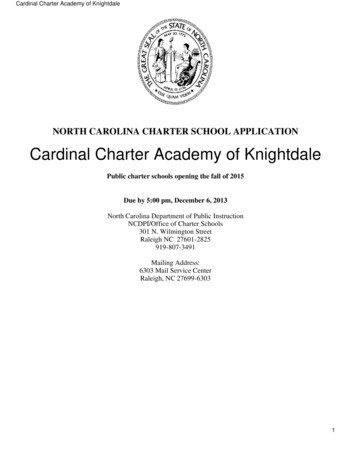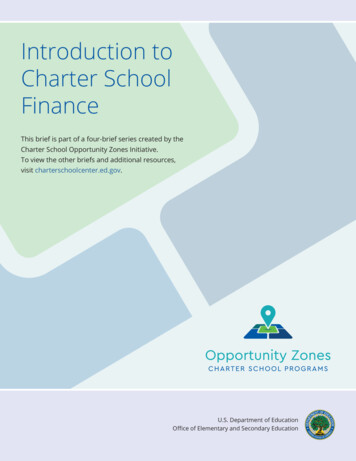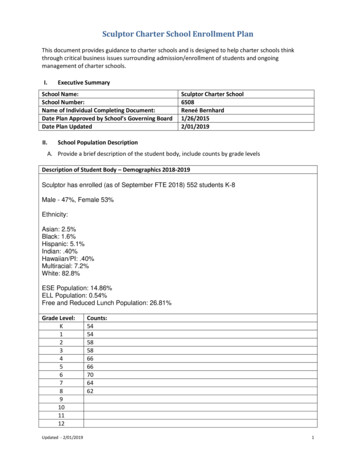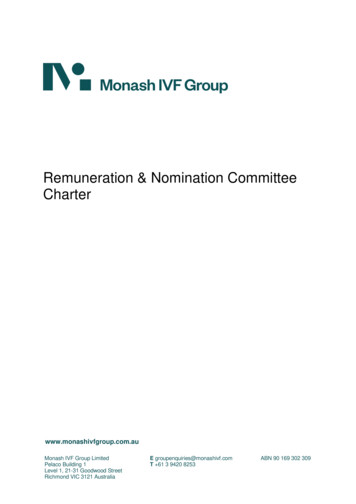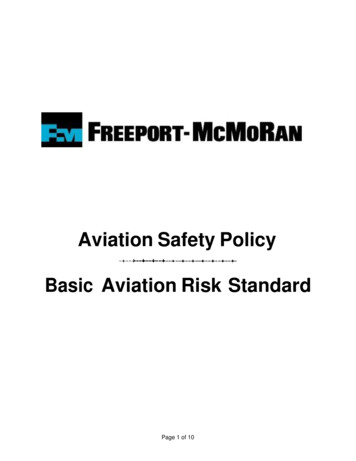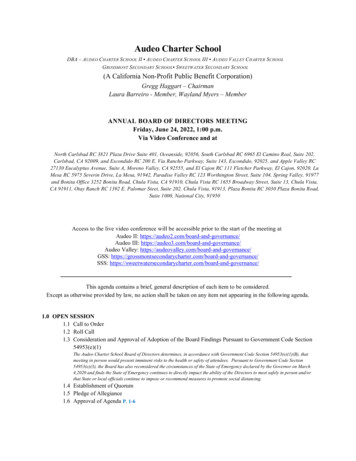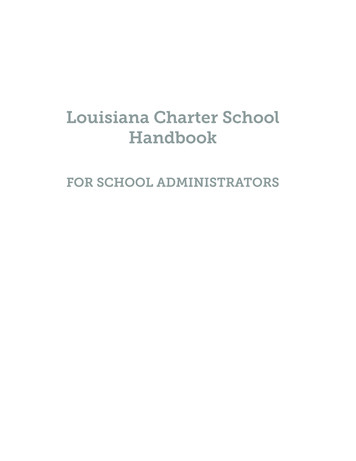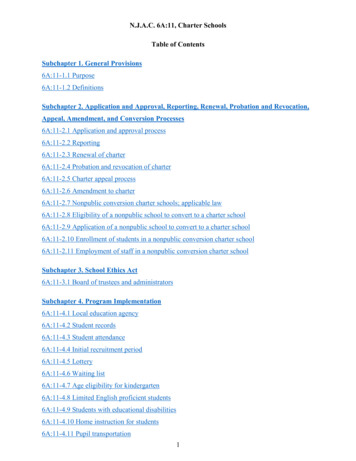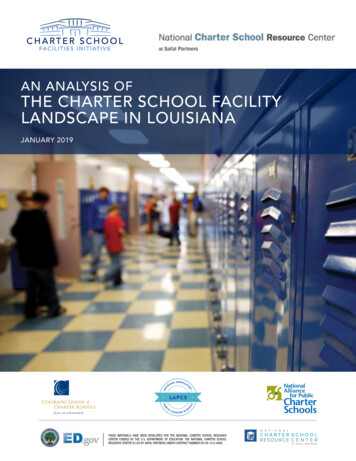
Transcription
AN ANALYSIS OFTHE CHARTER SCHOOL FACILITYLANDSCAPE IN LOUISIANAJANUARY 2019THESE MATERIALS HAVE BEEN DEVELOPED FOR THE NATIONAL CHARTER SCHOOL RESOURCECENTER FUNDED BY THE U.S. DEPARTMENT OF EDUCATION. THE NATIONAL CHARTER SCHOOLRESOURCE CENTER IS LED BY SAFAL PARTNERS UNDER CONTRACT NUMBER ED-OII-13-C-0065.
An Analysis of the Charter School Facility Landscape in Louisiana2019EXECUTIVE SUMMARYIn the spring of 2018, the NATIONAL CHARTER SCHOOL RESOURCE CENTER (NCSRC),the Colorado League of Charter Schools (the League), the Louisiana Association of PublicCharter Schools (LAPCS), and the National Alliance for Public Charter Schools (NationalAlliance) collaborated to collect data and information about charter school facilities and facilitiesexpenditures in the state of Louisiana. The data collection in Louisiana was supported by theCharter School Facilities Initiative (CSFI), which is a national project funded by the U.S. Departmentof Education to research charter school facilities and facilities expenditures across the country. Theinformation contained in this report is based on data collected from the Charter School FacilitiesSurvey in Louisiana for the 2017-18 school year.ii
An Analysis of the Charter School Facility Landscape in Louisiana2 0 19Key fndings include:1. Charter schools in the Orleans Parish operate more frequently in district facilities thancharter schools outside of the Orleans Parish. In the Orleans Parish, 81.7 percent of schools operated in a facility owned by the schooldistrict, while in Non-Orleans parishes, only 27.5 percent of schools operated in a facilityowned by the school district.2. Charter schools that operate in district facilities pay less for rent than schools thatoperate in facilities owned by other types of organizations. In 2017-18, the average charter school in Louisiana spent 276 per pupil on rent or1.9 percent of per pupil funding.Charter schools that rented their facility from a public school district paid 70 per pupil or0.5 percent of per pupil funding.Charter schools that rented their facility from a for-proft organization unrelated to theschool paid 941 per pupil or 6.9 percent of per pupil funding.iii
An Analysis of the Charter School Facility Landscape in Louisiana20193. Many Louisiana charter schools lack the technology, facility amenities, and specializedinstructional spaces they require to best implement their educational program. 17.6 percent of schools did not have suffcient internet, WAN, LAN, and Wi-Fi infrastructurefor their current and future testing, learning, and administrative bandwidth needs (18/102). In Louisiana, 38.2 percent of schools (39/102) reported to not have the necessary amenitiesto best implement their educational program.Additionally, 31.4 percent of charter schools (32/102) stated that their facility has limited theschool’s academic curriculum.4. Charter schools in Louisiana are planning on increasing student enrollment over the nextfve years, but over half of these charter schools do not have adequate space in theircurrent facility for additional students. 62.7 percent of schools reported that they plan to increase their student enrollment overthe next fve years (64/102). Of those schools that plan to grow, 53.1 percent do not have adequate space in theircurrent facility for their projected growth in fve years (34/64).5. There are underutilized or vacant district facilities throughout Louisiana. In Louisiana, 38.4 percent of charter schools have information available about vacant orunderutilized (30 percent or more unused capacity) traditional public school facilitiesnearby (38/99).Schools in the Orleans Parish have better access to this information with 51.7 percent ofschools (31/60) having access to information about vacant or underutilized traditional publicschool facilities.The Recommendations section further expands on the policy solutions that can be utilized toaddress the facilities challenges of Louisiana’s public charter schools.iv
An Analysis of the Charter School Facility Landscape in Louisiana2 0 19TABLE OF CONTENTSIntroductionKey Findings#1: Charter schools in the Orleans Parish operate more frequently in districtfacilities than charter schools outside of the Orleans Parish#2: Charter schools that operate in district facilities pay less for rent thanschools that operate in facilities owned by other types of organizations#3: Many Louisiana charter schools lack the technology, facility amenities,and specialized instructional spaces they require to best implement theireducational program#4: Charter schools in Louisiana are planning on increasing student enrollmentover the next five years, but over half of these charter schools do not haveadequate space in their current facility for additional students#5: There are underutilized or vacant district facilities throughout LouisianaConclusionsRecommendationsWRITTEN BYPUBLISHED BYLorna Beckett, Ph.D.Colorado League of Charter SchoolsNational Charter School Resource CenterDavid Mohr,Colorado League of Charter SchoolsLouisiana Public School Resource CenterColorado League of Charter SchoolsNational Alliance for Public Charter SchoolsAkash Verma,Colorado League of Charter SchoolsKevin Hesla,National Alliance for Public Charter Schools1
An Analysis of the Charter School Facility Landscape in Louisiana2019INTRODUCTIONCharter School Facilities Initiative BackgroundDuring the 2017-18 school years, charter schools across the United States served more than 3million students, accounting for approximately 6 percent of all K-12 public school students.1Nationwide, there has been increasing demand and need for charter schools, yet access toadequate school facilities is a continued barrier to the growth of the charter sector.2Public charter schools generally do not have equal access to adequate facilities. Traditionalpublic school districts typically have sole ownership of school facilities, and often charter schoolshave no legal rights to access these buildings.3 As a result, charter schools often operate in nontraditional spaces, such as strip malls, churches, or converted buildings, which place constraints oninstructional practices.4 Since these non-traditional spaces are not well-equipped to function as aschool, charter schools must spend additional funding on facilities in order to renovate an existingbuilding or build a facility to meet the needs of their students.5Additionally, charter school facilities often do not receive equal facilities funding.6 Public charterschools rarely receive the same amount of facilities funding as school districts and may not be ableto access tax-exempt fnancing.7 School district facilities also may beneft from local tax or bondrevenues that pay for facility construction and/or renovation, funding that charter schools typicallydo not have access to.8 The type of fnancing that charter schools can access varies by state, withsome states passing laws to help provide charter schools with better access to state funding andfnancing options.9 To help states advocate for equal facilities and funding access, there is a needfor additional research to collect data on state-specifc facilities challenges.123456789Wolfe, C. (2018). Strengthening Federal Investment in Charter School Facilities. National Alliance for PublicCharter Schools.Wolfe, C. (2018). Strengthening Federal Investment in Charter School Facilities. National Alliance for PublicCharter Schools.Smith, N. (2012). An Accident of History: Breaking the District Monopoly on Public School Facilities. NationalAlliance for Public Charter Schools.Wolfe, C. (2018). Strengthening Federal Investment in Charter School Facilities. National Alliance for PublicCharter Schools.Smith, N. (2012). An Accident of History: Breaking the District Monopoly on Public School Facilities. NationalAlliance for Public Charter Schools.Simnick, R. (2015). State Policy Snapshot: School District Facilities and Public Charter Schools. NationalAlliance for Public Charter Schools.Simnick, R. (2015). State Policy Snapshot: School District Facilities and Public Charter Schools. NationalAlliance for Public Charter Schools.Cunningham, J. (2011). Charter School Facilities. National Conference of State Legislatures.Simnick, R. (2015). State Policy Snapshot: School District Facilities and Public Charter Schools. NationalAlliance for Public Charter Schools.2
An Analysis of the Charter School Facility Landscape in Louisiana2 0 19History of the Charter School Facilities InitiativeThe Charter School Facilities Initiative began in Colorado in 2007, after the League heardanecdotal information about the number of inadequate and costly facilities throughout Colorado.In order to gather objective, reliable facilities data about Colorado’s charter community the Leaguedeveloped a comprehensive survey, the Charter School Facilities Survey. The League developedthe Charter School Facilities Survey in partnership with a national leader in school facilities, PaulHutton, AIA, of Cuningham Group Architecture, and experts in school planning, Wayne Eckerling,Ph.D. and Allen Balczarek. The League used this survey in Colorado during the 2007-08 schoolyear and published the results of the Charter School Facilities Survey in a 2008 report entitledShortchanged Charters: How Funding Disparities Hurt Colorado’s Charter Schools.Seeing the success of the Colorado facilities initiative, the National Alliance partnered with theLeague to use the Colorado facilities survey model in other states to assess the charter facilitieslandscape across the country. In a pilot program spanning six months in 2010-11, the League andthe National Alliance partnered with state charter school organizations (CSOs) in Georgia, Indiana,and Texas to collect state-specifc data comparable to what took place in Colorado. Since 2011, theLeague’s work through the CSFI has been funded by the U.S. Department of Education’s CharterSchool Program through a subcontract with the NCSRC. The CSFI informs policy and practice bycollecting and disseminating comprehensive data regarding the state of charter school facilities,including the cost and quality of charter school buildings, charter school access to school districtfacilities, and the availability of local and state funding for charter school facilities.Since 2010, the CSFI has collected data on over 2,000 charter school facilities across the UnitedStates. To date, 20 states have participated in the CSFI: Arkansas, California, Colorado, Delaware,Georgia, Idaho, Indiana, Louisiana, Massachusetts, Michigan, New Hampshire, New Jersey,New Mexico, New York, Ohio, Oklahoma, Rhode Island, South Carolina, Tennessee, and Texas.The results are published in a series of state‐specifc reports jointly authored by the League, theAlliance, and respective CSO partners available at http://facilitiesinitiative.org/.3
An Analysis of the Charter School Facility Landscape in Louisiana2019Charter Schools in LouisianaLouisiana’s charter school law was enacted in 1995 to “(a) improve pupil learning and, in general,the public school system; (b) increase learning opportunities and access to quality educationfor pupils; (c) encourage the use of different and innovative teaching methods and a variety ofgovernance, management, and administrative structures; (d) require appropriate assessment andmeasurement of academic learning results; (e) account better and more thoroughly for educationalresults; (f) create new professional opportunities for teachers and other school employees,including the opportunity to be responsible for the learning program at the school site.”10The charter school law allows two types of authorizers in Louisiana: local school boards and theBoard of Elementary and Secondary Education (BESE). These two authorizers can operate sixdifferent types of schools under Louisiana’s charter law: Type 1, Type 2, Type 3, Type 3B, Type 4,and Type 5. A description of each type is below:11 Type 1: A new charter school and authorized by a local school board. Type 2: A new charter school or a public school converted to a charter school andauthorized by the BESE. Type 3: A public school that converted to a charter school and authorized by a local schoolboard. Type 3B: Former Type 5 charter school that was transferred from the BESE back to the localschool board. Type 4: A new charter school or public school converted to a charter school authorized bythe local school board and BESE. Type 5: A Recovery School District (RSD) school. In 2003, the Louisiana legislature createdthe Recovery School District (RSD) to serve as the last intervention for schools that areconsidered turnaround.12 Schools that have been rated F for four consecutive years bythe Louisiana Department of Education are eligible for placement in the RSD.13 The RSDthen works with these schools to implement improvement plans and increase schoolperformance.14 If a school improves its performance, it can be transferred from the RSDback to the local school board and becomes a Type 3B school.1011121314Charter School Demonstration Programs Law. (1995). 42-3972.Charter School Demonstration Programs Law. (1995). 42-3973.Louisiana Department of Education. (2018). Recovery School District Defned. rce/recovery-school-district/rsd-defned.pdf?sfvrsn 2Louisiana Department of Education. (2018). Recovery School District Defned. rce/recovery-school-district/rsd-defned.pdf?sfvrsn 2Louisiana Department of Education. (2018). Recovery School District Defned. rce/recovery-school-district/rsd-defned.pdf?sfvrsn 24
An Analysis of the Charter School Facility Landscape in Louisiana2 0 19During the 2017-18 school year, there were 146 charter schools in Louisiana across all six typesof charter schools. The table below lists the different types of charter schools, and provides abrief description of who authorizes them and the number of schools per type for the 2017-18school year.15Table 1. Types of Charter Schools in LouisianaTypeType of SchoolAuthorizerNumber of SchoolsType 1New schoolLocal School Board30Type 2New or conversionschoolBESE42Type 3Conversion schoolLocal School Board13Type 3BFormer Type 5 charterschool transferred backto local school systemLocal School Board14Type 4New or conversionschoolLocal School Board &BESE1Type 5Recovery SchoolDistrict schoolsBESE4615Louisiana Department of Education (2018). oversight-andsupport5
An Analysis of the Charter School Facility Landscape in Louisiana2019Charter Schools in New OrleansPrior to Hurricane Katrina, the Orleans Parish16 was one of the worst performing school districtsin the country. In 2005, only one-third of students in New Orleans were profcient on stateassessments and 63 percent of New Orleans students attended a failing school.17 After HurricaneKatrina, the Louisiana Legislature placed most Orleans Parish schools in the RSD.18 Since 2005,student achievement in the Orleans Parish has improved dramatically, and as of the 2017-18 schoolyear, 12 percent of New Orleans students attended a failing school.19 Additionally, 93 percent ofpublic school students in the Orleans Parish attend a charter school.20 In the 2018-19 school year,all RSD schools from the Orleans Parish will return back to the Orleans Parish School Board, and willno longer be part of the RSD.21In addition to low school performance prior to Hurricane Katrina, the school facilities in the OrleansParish were also in need of renovation.22 In 2005, Hurricane Katrina signifcantly damaged ordestroyed most school buildings, rending many of them unusable.23 In 2008, the School FacilitiesMaster Plan was created with the goal of providing every student in the Orleans Parish access toa new, renovated, or refurbished facility.24 The School Facilities Master Plan is one of the largestschool disaster recovery programs in the United States, with 1.8 billion dollars dedicated to facilityrepairs and construction funded by FEMA.25 The RSD is responsible for administering the SchoolFacilities Master Plan in addition to implanting school improvement plans for schools throughoutLouisiana.16171819202122232425School districts in Louisiana are referred to as parishes.Louisiana Department of Education. (2018). Recovery School District Defned. rce/recovery-school-district/rsd-defned.pdf?sfvrsn 2Louisiana Department of Education. (2018). Recovery School District Defned. rce/recovery-school-district/rsd-defned.pdf?sfvrsn 2Louisiana Department of Education. (2018). Recovery School District Defned. rce/recovery-school-district/rsd-defned.pdf?sfvrsn 2Sims, P. & Rossmeier, V. (2015). The State of Public Education in New Orleans: 10 Years After HurricaneKatrina. The Cowen Institute for Public Education Initiatives at Tulane University.Louisiana Department of Education. (2018). Recovery School District Defned. rce/recovery-school-district/rsd-defned.pdf?sfvrsn 2Sims, P. & Rossmeier, V. (2015). The State of Public Education in New Orleans: 10 Years After HurricaneKatrina. The Cowen Institute for Public Education Initiatives at Tulane University.Sims, P. & Rossmeier, V. (2015). The State of Public Education in New Orleans: 10 Years After HurricaneKatrina. The Cowen Institute for Public Education Initiatives at Tulane University.Louisiana Department of Education. (2018). Recovery School District Defned. rce/recovery-school-district/rsd-defned.pdf?sfvrsn 2Louisiana Department of Education. (2018). Recovery School District Defned. rce/recovery-school-district/rsd-defned.pdf?sfvrsn 26
An Analysis of the Charter School Facility Landscape in Louisiana2 0 19Charter School Facilities Law in LouisianaLouisiana law created the Louisiana Charter School Start-Up Fund, which provides zero-interestloans to both new and existing charter schools for up to 100,000.26 The loans can have termsof up to three years, and the loans can be used for facility repairs, renovations, or acquisitions.27However, Louisiana is not currently funding this program, so charters are unable to access thesefunds.28 Louisiana law also states that through the Louisiana Public Facilities Authority chartersare eligible for tax-exempt fnancing.29 Additionally, local school boards are required to make anyvacant district school facilities available to charter schools for lease or purchase.302627282930National Alliance for Public Charter Schools. (2018). Louisiana. w-database/states/louisianaIbid.Ibid.Ibid.Ibid.7
An Analysis of the Charter School Facility Landscape in Louisiana2019Each year, the National Alliance evaluates state charter schools laws and assigns an overall rankingto each state based on a corresponding evaluation rubric.31 In 2018, the National Alliance rankedLouisiana #12 on its charter law out of 45 states.32 NAPCS states in the report that one of thebiggest areas for improvement in Louisiana’s law is providing equitable facilities funding to charterschools.33 In the category “Equitable Access to Capital Funding and Facilities” Louisiana receiveda score of 1 out of 4, due to a “state law that includes a small number of the model law’s provisionsfor equitable access to capital funding and facilities.”34 Based on the NACPS evaluation Louisianalaw does not have the following essential components of a strong charter school law: A per-pupil facilities allowance that annually refects average district capital costs. A state grant program for charter school facilities. Equal access to existing state facilities programs available to non-charter public schools. A requirement for districts to provide school district space or funding to charter schools ifthe majority of that school’s students reside in that districts.A state loan program for charter school facilities.Pledging the moral obligation of the state to help charter schools obtain more favorablebond fnancing terms. The creation and funding of a state charter school debt reserve fund. A mechanism to provide credit enhancement for charter school facilities. 3132333435Charter schools allowed to contract at or below fair market value with a school district, acollege or university, or any other public or for-proft or nonproft private entity for the useof facility for a school building.Certain entities allowed to provide space to charter schools within their facilities under theirpreexisting zoning and land use designations.Charter school facilities exempt from ad valorem taxes and other assessment fees notapplicable to other public schools.35National Alliance for Public Charter Schools. (2018). Charter Law Rankings FAQ. w-database/charter-law-rankings-faq#modellawNAPCS. (2018). Measuring Up To The Model: A Ranking of State Public Charter School Laws. NAPCS.Ibid.Ibid.NAPCS. (2018). Louisiana. w-database/states/louisiana8
An Analysis of the Charter School Facility Landscape in Louisiana2 0 19MethodologyThe information contained in this report is based on data collected from the Charter SchoolFacilities Survey in Louisiana during the 2017-18 school year. The Charter School FacilitiesSurvey consists of 55 base questions which are used in every participating state, with an optionfor participating states to include 15 additional state-specifc questions that capture the localcharter school facilities context. LAPCS added 15 additional custom questions on facilities issuesspecifc to Louisiana. Topics addressed in the survey include the following: waiting lists and futurefacility plans; facility ownership and co-location; facility amenities and instructional spaces; facilitycondition and security; and facility funding and expenditures.The CSFI team identifed 146 brick and mortar Louisiana charter school facilities that were eligibleto participate in the survey. The survey was sent electronically to the school leaders at all eligiblecharter schools. Survey data was collected between March and April of 2018. As necessary, theLAPCS and the CSFI team provided technical assistance to schools completing the survey and eachsurvey was reviewed for accuracy and completeness. School leaders at 103 eligible charter schoolfacilities completed the Charter School Facilities survey.In addition to the data collected in the survey, the League also collected additional data onschool enrollment, student demographics, and school funding from the Louisiana Departmentof Education. The policy recommendations presented in the “Recommendations” section arebased on the charter school facility landscape in Louisiana, the national facility landscape, and thecollective expertise of the NCSRC, the League, the LAPCS, and the National Alliance.9
An Analysis of the Charter School Facility Landscape in Louisiana2019Sample Description103 schools participated in the Charter School Facilities Survey in Louisiana during the 2017-18school year. Throughout this report, the results are reported disaggregated by group: Orleans andNon-Orleans. The Orleans group includes all of the schools that participated in the survey that arelocated in Orleans Parish36 and the Non-Orleans group includes all of the schools that participatedin the survey located in any parish other than Orleans Parish. In this sample, 60 percent of schoolswere from Orleans Parish, and 40 percent of schools were from Non-Orleans parishes.Figure 1Survey Respondents by ParishNon-New Orleans40%New Orleans60%In Louisiana, 35.3 percent (36/102) of charter schools had a waitlist in 2017-18. For schools that hada waitlist in 2017-18, the average number of students on the waitlist was 142. In charter schoolswith an enrollment less than 500 the average number of students on the waitlist per school was 74and that for charter schools with an enrollment equal to or greater than 500 the average number ofstudents on the waitlist per school was 240 in 2017-18.36School districts in Louisiana are referred to as parishes.10
An Analysis of the Charter School Facility Landscape in Louisiana2 0 19KEY FINDINGSKey Finding #1: Charter schools in the Orleans Parish operate more frequently indistrict facilities than charter schools outside of the Orleans Parish.Traditional public schools operate in facilities that are owned by the school district while charterschools can operate in facilities that are owned by many different types of organizations. Thesurvey found that overall charter schools in Louisiana operate in facilities owned by several differententities: 8.0 percent of schools were in a facility owned by the charter school (8/100). 60.0 percent of schools were in a facility owned by the traditional public school districts(60/100). 4.0 percent of schools were in a facility owned by a government entity other than atraditional public school district (4/100). 7.0 percent of schools were in a facility owned by a for-proft organization related to theschool (7/100). 5.0 percent of schools were in a facility owned by a for-proft organization unrelated theschool (5/100).10.0 percent of schools were in a facility owned by a non-proft organization unrelated tothe school (10/100). 4.0 percent of schools were in a facility owned by a non-proft organization related to theschool (4/100). 2.0 percent of schools were in a facility owned by more than one of the organizations listedabove (2/100).Figure 2Statewide Facility Ownership Averages8%60%The schoolPublic school district4%Government entity other than traditional school district7%For-proft company unrelated to the school5%For-proft company related to the school10%Non-proft organization unrealted to the school4%Non-proft organization related to the school2%More than one of the above11
An Analysis of the Charter School Facility Landscape in Louisiana2019While the overall averages make it seem as if the majority of charter schools operate in facilitiesthat are owned by the traditional public school district, schools in the Orleans Parish actuallyoperate in district facilities at a much higher percentage than schools in the Non-Orleans parishes.Table 2 displays the facility ownership by parish.Table 2. Facility Ownership by ParishOwnershipOrleansNon-OrleansThe school0.0%20.0%Public school district81.7%27.5%Government entity other than a traditionalschool district3.3%5.0%For-proft company unrelated to the school3.3%12.5%For-proft company related to the school1.7%10.0%Non-proft organization unrelated to theschool5.0%17.5%Non-proft organization related to the school1.7%7.5%More than one of the above3.3%0.0%Table 2 indicates that in the Orleans Parish, 81.7 percent of schools operated in a facility ownedby the school district, while in Non-Orleans parishes, only 27.5 percent of schools operated ina facility owned by the school district. However, in the Non-Orleans parishes, 20.0 percent ofschools operate in a facility they own, while none of the schools in the Orleans Parish own theirschool facility. Across Louisiana, schools in the Orleans Parish have better access to district facilitiesthan in the Non-Orleans parishes, but schools in Non-Orleans parishes are better able to build theirown facilities.12
An Analysis of the Charter School Facility Landscape in Louisiana2 0 19Key Finding #2: Charter schools that operate in district facilities pay less for rentthan schools that operate in facilities owned by other types of organizations.73.0 percent of schools pay for their facility and/or land associated with the facility (73/100). Theaverage amount paid by the schools was 95,189. The average annual rent paid by a school inthe Orleans Parish was 70,101 and in the Non-Orleans parishes was 149,727. Using per-pupilrevenue data from the Louisiana Department of Education, we were able to calculate the averagerent payment as a percent of per-pupil revenue (PPR). In 2017-18, the average charter school inLouisiana spent 276 per pupil on rent or 1.9 percent of per pupil funding.The per-pupil rent varied based on the ownership of the school facility: 37Charter schools that rented their facility from a public school district paid 70 per pupilor 0.5 percent of per pupil funding (50/60).Charter schools that rented their facility from a government entity other than the publicschool district paid 897 per pupil or 4.7 percent of per pupil funding (2/4).Charter schools that rented their facility from a for-proft organization unrelated to theschool paid 941 per pupil or 6.9 percent of per pupil funding (7/7).Charter schools that rented their facilities from a for-proft organization related to the schoolpaid 513 per pupil or 3.8 percent of per pupil funding (2/5).Charter schools that rented their facilities from a non-proft organization unrelated to theschool paid 651 per pupil or 4.4 percent of per pupil funding (9/10).Charter schools that rented their facilities from a non-proft organization related to theschool paid 627 per pupil or 3.4 percent of per pupil funding (2/4).A charter school that rented their facility from more than one of the above organizationspaid 131 per pupil or 1.2 percent of per pupil funding (1/2).37The survey did not ask questions about loan or other fnancing payments for charter schools that own theirbuildings.13
An Analysis of the Charter School Facility Landscape in Louisiana2019A breakdown of the rent expense by parish can be seen in the table below.Table 3. Facility Cost by Type of Ownership and ParishOrleansOwnershipNon-OrleansRent Per Pupil% of PPRRent Per Pupil% of PPR 420.3% 1971.6%Governm
An Analysis of the Charter School Facility Landscape in Louisiana 2019. Charter Schools in Louisiana . Louisiana's charter school law was enacted in 1995 to "(a) improve pupil learning and, in general, the public school system; (b) increase learning opportunities and access to quality education


